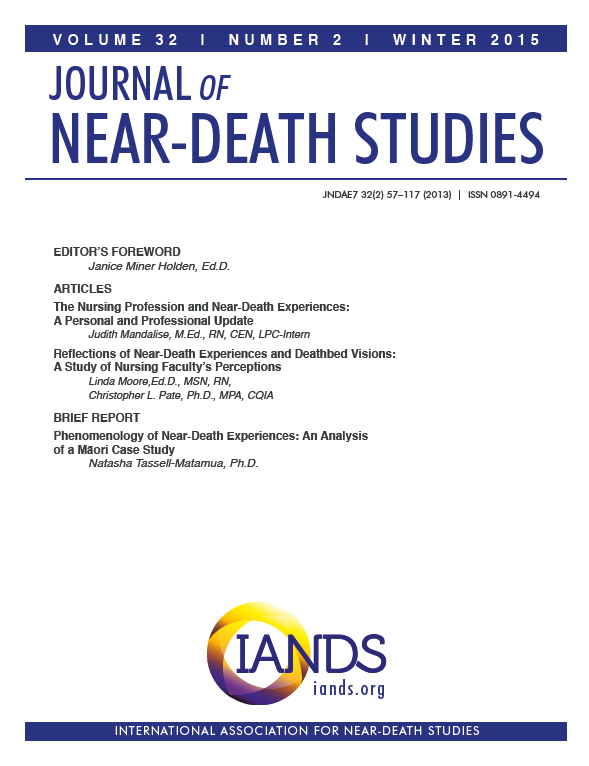The Journal of Near-Death Studies encourages submission of articles on the topics of the phenomenology, aftereffects, and implications of near-death experiences (NDEs) and related transpersonal (transcending the usual personal limits of space, time, and/or identity) experiences. Categories of submission include: research reports; theoretical or conceptual statements; papers expressing a particular scientific, philosophic, religious, or historical perspective on the study of near-death and related experiences; cross-cultural studies; individual case histories with instructive unusual features; and personal accounts with instructive unusual features.
- GENERAL REQUIREMENTS
- Manuscripts should be formatted according to the current edition of the Publication Manual of the American Psychological Association. Logical organization is essential. Although headings help to structure the content, titles and headings within the manuscript should be as short as possible. Do not use the general masculine pronoun or other sexist terminology.
- MANUSCRIPTS
- may be submitted in electronic format (preferred) or hard copy. Electronic manuscripts may be submitted by email to the Editor, Janice Holden, at This email address is being protected from spambots. You need JavaScript enabled to view it.; preferred format is Microsoft Word. Manuscripts submitted as hard copy should be typed on only one side of the page and mailed to:
- Janice Holden, EdD
- 1004 Vista Court
- Lewisville, TX 75067
- USA
- Manuscripts should be double spaced throughout, with a margin of at least one inch on all four sides, and all pages numbered in upper right corner. There are no absolute limits on length of articles, but authors should strive for conciseness.
- TITLE PAGE
- should contain the names of the authors, as well as their academic degrees, institutional affiliation(s), title(s), phone number, and email address for the senior author.
- ABSTRACT
- An abstract of 100-200 words is required with each manuscript. The abstract should include the major premises of the article, intent, hypotheses, research design, results, conclusions, and implications of results. For review or discussion articles, identify the main themes and conclusions and reflect them in a balanced fashion; if sources are important (for example, previous research), include these. For other types of articles, including replies to other authors' articles or case histories, refer briefly to the main themes and conclusions, and cross-reference if necessary. Abstracts should be nonevaluative in tone and should include as much information as possible within the constraints of space.
- KEY WORDS
- Each manuscript should include two to five key words, listed after the abstract, which will be printed in the Journal and used by abstracting services for indexing the article. Key words are unnecessary for book reviews and letters to the editor.
- FOOTNOTES AND ENDNOTES
- are strongly discouraged.
- REFERENCES
- should be listed in alphabetical order (and chronologically for each author) at the end of the manuscript, and referred to in the text by author(s) and year of publication. Only items cited in the text, and every item cited, should be listed in the References. Personal communications (for example, K. Ring, personal communication, June 6, 1997) and Internet websites (for example, www.iands.org) may be cited in the text but should not be included in the list of references. Include all authors in references with multiple authors. Do not abbreviate journal titles. Capitalize principal words in journal titles but only the first word in a book title or subtitle. Examples:
- Book:
- Ring, K. (1980). Life at death: A scientific investigation of the near-death experience. Coward, McCann and Geoghegan.
- Article:
- Furn, B. G. (1987). Adjustment and the near-death experience: A conceptual and therapeutic model. Journal of Near-Death Studies, 6, 4-19. https://doi10.17514/JNDS-1987-6-1-p4-19.
- Chapter in edited book:
- Ivey, A. (1981). Counseling and psychotherapy: Toward a new perspective. In A. J. Marsella & P. B. Petersen (Eds.), Cross-cultural counseling and psychotherapy (pp. 198-223). Pergamon.
- ILLUSTRATIONS
- should be self-explanatory and used very sparingly. Tables and figures must be in camera-ready condition and include captions. Artwork submitted electronically should be in TIFF, EPS, or PDF format (1200 dpi for line and 300 dpi for halftones and gray-scale art). Color art should be in the CMYK color space. Artwork should be in a separate file from the text.
- NUMBERS AND NUMERALS
- When referring to statistics or a person's age, use numerals ("55%"; "4 of 42 cases"; "9 years old"). In other circumstances, spell out single digit numbers, and use numerals for multiple digit numbers ("the three questionnaires each contained 24 questions").
- TENSE
- In reviewing the literature, use the past tense for occurrences at a definite time in the past ("Smith [2012] reported similar results") or present perfect tense for occurrences beginning in the past and continuing ("Many researchers have used this instrument"). In describing results of your study, use the past tense ("the subjects performed as predicted"). In presenting conclusions from your data, use the present tense ("these data confirm our hypothesis").
- ABBREVIATIONS
- Use "NDE," "NDEs" (not "NDE's"), "NDEr" (not "NDEer"); "OBE" (not "OOBE"), "OBEs" (not "OBE's"), "OBEr" (not "OBEer"). Define each abbreviation or acronym the first time it is used. Example: "Near-death experiences (NDEs) are often profound psychological events."
- QUOTATIONS
- Quotations of 40 or more words should be indented as a block of text. Please double space quotations, however, to leave room for editing. All direct quotes, regardless of length, must have proper reference to their original source, including page number for published sources or date for personal communications.
- COMMAS
- Separate the final two items in a series of three or more words or phrases with a comma (Ring, Moody, and Sabom; during the day, during dusk, and at night). Insert a comma before the conjunction of a compound sentence in which the second clause is independent (containing its own subject) but not dependent. Example: Ring recruited participants, and he then divided them into two groups; Ring recruited participants and divided them into two groups.
- PERSONAL NAMES
- When referring to a person, regardless of the persons's degree, title, or gender, use full name in the first reference and only last name in subsequent references. Example: "In this book, Michael Sabom, a cardiologist, brought a medical perspective to the study of NDEs. Sabom himself was roused to question his scientific dogmas . . . ." Honorifics ("Mr. Smith," "Ms. Jones," "Dr. Moody") and academic degrees ("Kenneth Ring, PhD," "Michael Sabom, MD") are not used in the text of the article but are used in the author's byline and in bibliographical and acknowledgment footnotes.
- FIRST PERSON
- Use "I" to refer to a single author. Use "we" to refer to more than one author. Do not use "we" to refer to humans; instead, use a word such as "humans," "people," or "individuals." Use "I" or "we" rather than the passive construction ("We asked subjects to..." rather than "Subjects were asked to...").
- OTHER TERMS
- Use "near-death experiencer," not "near-death experient"; "out-of-body experience," not "out-of-the-body experience." Use "data" as a plural noun.
For help with any other questions of style, see a recent issue of the Journal of Near-Death Studies or the current edition of the Publication Manual of the American Psychological Association.


